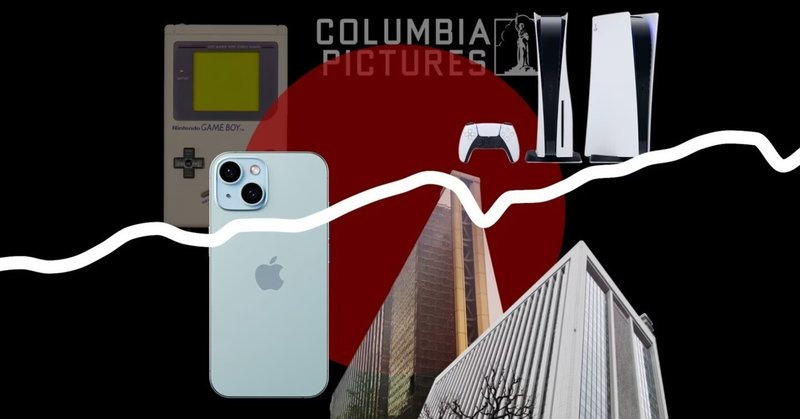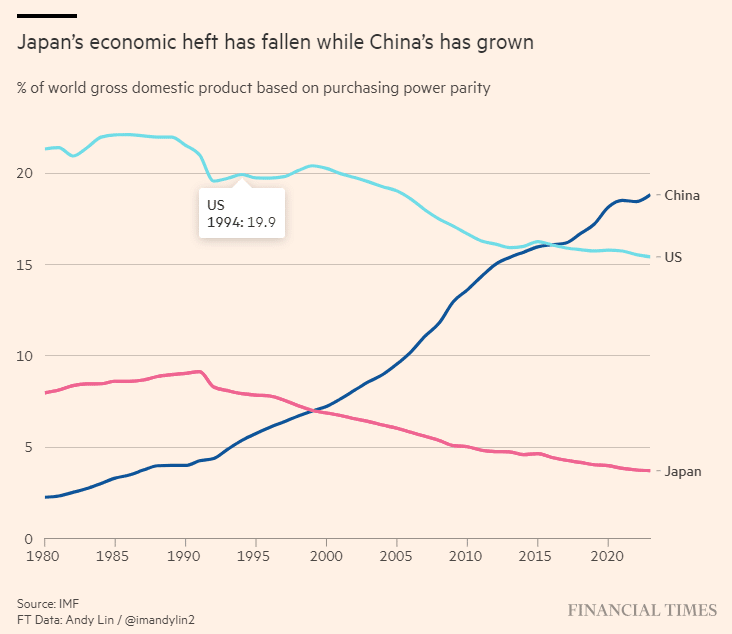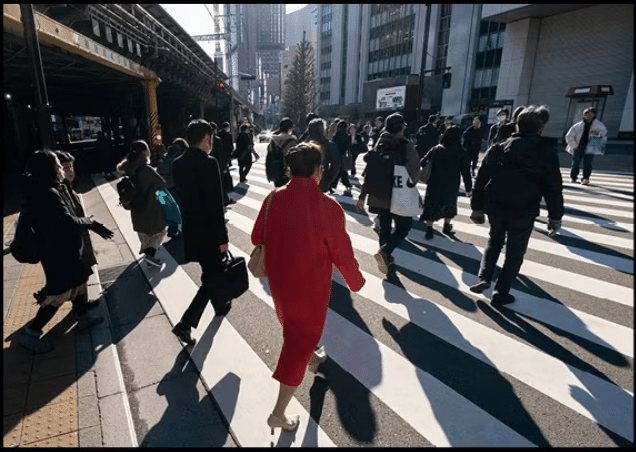
日本の株式市場は34年ぶりに復活したが、この国は大きく変わった/FTを読む
Japan’s stock market is back after 34 years but the country is deeply changed
日本の株式市場は34年ぶりに復活したが、この国は大きく変わった
In late 1989, no person better symbolised Japan’s postwar rise to economic superpower than Akio Morita, Sony’s co-founder, who stunned the world with a $3bn acquisition of Columbia Pictures.
1989年末、30億ドルでコロンビア映画を買収して世界を驚かせたソニーの共同創設者、盛田昭夫ほど、戦後日本の経済大国への台頭を象徴する人物はいなかった。
That same year, an unauthorised English translation of an explosive essay he co-authored, titled “The Japan That Can Say No”, went viral among America’s elite. Citing what he saw as the short-termism of US businesses, Morita warned: “You may never be able to compete with us.”
同年、彼が共著した「ノーと言える日本」というタイトルの爆発的なエッセイの無断英語翻訳がアメリカのエリート層の間で広まった。 盛田氏は米国企業の短期主義を引き合いに出し、「我々と競争することは決してできないかもしれない」と警告した。
It was a display of arrogance he later regretted, but it brilliantly captured the mood in Japan as its companies and billionaires dominated rankings of the world’s most valuable and richest.
これは後に彼が後悔した傲慢さの表れだったが、日本の企業や億万長者が世界で最も価値のある富裕層のランキングを独占している日本の雰囲気を見事に捉えたものだった。
On Thursday the Nikkei 225 stock index finally surpassed the level reached 34 years ago. But gone is the sense of euphoria or achievement that was prevalent in 1989, when Japanese exports of cars and televisions soared and a rise in property prices appeared unstoppable.
木曜日、日経平均株価指数はついに34年前に達した水準を超えた。 しかし、日本の自動車やテレビの輸出が急増し、不動産価格の上昇が止まらないと思われた1989年に広がっていた多幸感や達成感はもう過去のものとなった。
While the world has scrambled to bring inflation under control over the past year, Japan has yet to officially declare an exit from deflation and remains the only country with interest rates below zero. The clearest threat for the US now is the rise of China, while Japan has ceded its edge in consumer electronics and chips to rivals in South Korea and Taiwan.
この1年、世界がインフレ抑制に躍起になっている中、日本はまだデフレ脱却を正式に宣言しておらず、金利がゼロ以下の唯一の国のままだ。 現在、米国にとっての明らかな脅威は中国の台頭であり、一方、日本は家電製品やチップ分野での優位性を韓国や台湾のライバルに譲っている。

Back then, policymakers were raising taxes and interest rates to calm everything down, said Jesper Koll, a market commentator who was an economist at Warburg. “Today they are all-in pro-growth, and worried about the risk of deflation returning.”
この1年、世界がインフレ抑制に躍起になっている中、日本はまだデフレ脱却を正式に宣言しておらず、金利がゼロ以下の唯一の国のままだ。 現在、米国にとっての明らかな脅威は中国の台頭であり、一方、日本は家電製品やチップ分野での優位性を韓国や台湾のライバルに譲っている。
In 1989, Japan was all-in in its bullishness. Today, domestic Japan is not even mildly optimistic.
1989年、日本は全力で強気だった。 現在、日本国内は少しも楽観的ではありません。
According to a 2022 Nippon Foundation survey of 17-19-year-olds in China, India, the UK, US, South Korea and Japan, young Japanese had by far the lowest percentage (13.9 per cent) who thought the country would improve.
中国、インド、英国、米国、韓国、日本の17~19歳を対象とした2022年の日本財団の調査によると、日本の若者は国が改善されると考える割合が最も低く(13.9%)だった。
While Japan is now attracting global investors, “we should not enjoy it too much”, said Takeshi Niinami, chief executive of drinks group Suntory and chair of the Japan Association of Corporate Executives business lobby. “The yen is cheap and I’m afraid that investors will all of a sudden go and we’re left with an empty field.”
日本は現在世界の投資家を惹きつけているが、「あまり享受すべきではない」と飲料グループサントリーの最高経営責任者で経済同友会ビジネスロビー会長の新浪剛史氏は言う。 「円は安いので、投資家が突然去ってしまい、空き地が残るのではないかと心配しています。」


1989
日本は株価と不動産価格の上昇により、輝かしい10年間の成長を享受してきた。 ある計算によると、皇居はカリフォルニア州と同じくらいの価値がありました。


この国は借金を抱え、長年のデフレからかろうじて脱却している
As the 1980s drew to a close, Tokyo was celebrating a stellar decade during which the economy had grown by an average of 4 per cent a year on the back of soaring stock and property prices.
1980 年代が終わりに近づくにつれ、東京は株価と不動産価格の高騰を背景に経済が年平均 4% 成長した輝かしい 10 年を祝っていました。
But by the summer of 1989, Kazuo Ueda, the current Bank of Japan governor who was teaching at the University of Tokyo at the time, was already worried. “The recent rise in Japanese shares is a bubble, and it could burst any time,” he warned in a column for the Nikkei newspaper.
しかし、1989年の夏の時点で、当時東京大学で教鞭を執っていた現日本銀行総裁の植田和男氏はすでに懸念を抱いていた。 同氏は日経新聞のコラムで「最近の日本株の上昇はバブルであり、いつ崩壊してもおかしくない」と警告した。
In May that year, the central bank began raising interest rates to head off inflation, increasing its discount rate from 2.5 per cent to 6 per cent by August 1990. As asset prices collapsed, financial institutions and property developers struggled to get rid of bad loans, triggering a banking crisis. The BoJ began to cut interest rates, and by 1999, inflation was below zero.
同年5月、中央銀行はインフレを阻止するために利上げを開始し、1990年8月までに割引率を2.5%から6%に引き上げた。資産価格が暴落したため、金融機関や不動産開発業者は不良債権処理に苦慮し、銀行危機を引き起こした。日銀は利下げを開始し、1999年までにインフレ率はゼロを下回った。
The Japanese economy entered a long period of stagnation during the 2000s, when the economy grew on average only 0.7 per cent. As mild deflation continued, people stopped believing that prices or wages would go up. Debt has also risen. The IMF expects Japan’s ratio of public debt to gross domestic product to reach 256 per cent in 2024, compared with 65 per cent in 1989.
日本経済は2000年代に長期停滞期に入り、経済成長率は平均0.7%にとどまった。 緩やかなデフレが続くと、人々は物価や賃金が上がると信じなくなりました。 借金も増えました。 IMFは日本の公的債務の対国内総生産(GDP)比率が1989年の65%から2024年には256%に達すると予想している。
日本の生活水準はG7諸国の中で最下位に落ちている
購買力平価に基づく一人当たりの GDP (2017 年の一定国際ドル)

Today, the economy is at a turning point. The BoJ is preparing to begin its gradual exit from its ultra-loose monetary policy as soon as this spring. More companies are raising prices and labour shortages are contributing to higher wages.
今、経済は転換点を迎えています。 日銀は早ければ今春にも超緩和政策からの段階的な出口を開始する準備を進めている。 値上げする企業が増え、人手不足が賃金上昇につながっている。
In a speech in early February, Shinichi Uchida, the BoJ’s deputy governor, voiced optimism: “We are now facing the opportunity to break out of the mindset and behaviour of the deflationary period.”
日銀副総裁の内田伸一氏は2月初旬の講演で、「われわれは今、デフレ時代の考え方や行動から脱却する機会に直面している」と楽観的な見方を表明した。
Still, there is little sense of euphoria. The economy has contracted for two consecutive quarters, with household consumption remaining weak. “I wouldn’t call this a bubble,” said Koji Toda, a fund manager at Resona Asset Management. “And there is still no certainty of overcoming deflation.”
それでも、高揚感はほとんどありません。 経済は2四半期連続で縮小し、家計消費は依然として低迷している。 りそなアセットマネジメントのファンドマネジャー、戸田浩司氏は「これをバブルとは呼ばない」と語った。 「そしてデフレを克服する確実性はまだありません。」


1989年
日本経済は金融資産バブルの真っ只中にあり、銀行が国内最大手企業のリストを独占していた


2024年
日本の金融情勢は合併や再編を通じて変化してきました。 新しいテクノロジー企業が台頭しているが、自動車メーカーのトヨタは依然としてこの国で最も価値のある企業であることに変わりはない
When Nippon Steel announced its all-cash $14.9bn takeover bid for US Steel in December, bankers saw the purchase as a sign of the return of Japan’s cash-rich companies to global markets.
新日鉄が12月に全額現金149億ドルでUSスチールに買収提案を発表したとき、銀行家らはこの買収を、資金豊富な日本企業が世界市場に復帰する兆しとみなした。
But if the M&A deals of the 1980s were a demonstration of Japan Inc’s ambitions to take on the world, corporate executives say today’s overseas rush is driven by the need to find new revenue outside their rapidly ageing and shrinking home market.
しかし、1980年代のM&A取引が日本企業の世界を相手にする野心の表れだとすれば、企業幹部らは、今日の海外ラッシュは急速に高齢化し縮小する国内市場以外で新たな収益を見つける必要性によって動かされていると語る。
Following a domestic banking crisis and the bankruptcy of Lehman Brothers in 2008, Japanese groups such as Sony, Panasonic and Hitachi entered a long and painful period of restructuring.
2008年の国内銀行危機とリーマン・ブラザーズの破綻後、ソニー、パナソニック、日立などの日本のグループは長く苦しい再編の時期に入った。
In 1989 Japanese companies, particularly banks, dominated the global top 10 by market capitalisation. No Japanese companies make the top 10 now.
1989年には日本企業、特に銀行が時価総額で世界トップ10を独占した。 現在、トップ10に入る日本企業はない。
Today, Toyota has risen to become the world’s largest carmaker by sales and the most valuable company in Japan. Sony, which is now more famous for its entertainment business and PlayStation games than the Walkman portable music player, is ranked third while semiconductor equipment maker Tokyo Electron is fifth.
現在、トヨタは売上高で世界最大の自動車メーカーとなり、日本で最も価値のある企業に成長しました。 今や携帯音楽プレーヤー「ウォークマン」よりもエンターテインメント事業やプレイステーションのゲームで有名なソニーが3位、半導体製造装置メーカーの東京エレクトロンが5位となった。
1989 stock market boom was fuelled by financial sector while recent rally has benefited from manufacturing revival
1989 年の株式市場ブームは金融セクターによって促進されましたが、最近の株価上昇は製造業の復活によって恩恵を受けました

In 1989, six of the world’s 10 richest people were Japanese. At the top of the list was Yoshiaki Tsutsumi, the former owner of Seibu Railway, whose wealth Forbes estimated at $15bn.
1989年には、世界で最も裕福な10人のうち6人が日本人でした。 リストのトップは、フォーブス誌がその資産を150億ドルと見積もった、西武鉄道の元オーナーである堤義明氏だった。
Now, only three Japanese people are ranked among the world’s top 100 billionaires, with Tadashi Yanai, founder of Uniqlo owner Fast Retailing, and his family ranked 30th with an estimated net worth of $40bn.
現在、世界の億万長者上位100人にランクインしている日本人は3人だけで、ユニクロオーナーであるファーストリテイリングの創業者柳井正氏とその家族は推定純資産400億ドルで30位にランクされている。
In terms of earnings, Japanese companies have emerged from the period of low growth with healthy balance sheets. According to finance ministry data, net profits generated by Japanese non-financial companies increased more than fourfold to ¥74tn ($493bn) from fiscal 1989 to fiscal 2022, while the amount of dividends they paid to shareholders jumped eightfold to ¥32tn during the same period.
収益の面では、日本企業は健全なバランスシートを持って低成長時代から脱却しました。 財務省のデータによると、日本の非金融企業が生み出した純利益は1989年度から2022年度までに4倍以上の74兆円(4,930億ドル)に増加し、同期間に株主に支払った配当額は8倍の32兆円に急増した。
Decades of deflation and economic stagnation, however, have also sapped the appetite for investment, leaving companies sitting on a massive cash pile of ¥343tn.
しかし、数十年にわたるデフレと経済停滞によって投資意欲も減退し、企業は343兆円もの巨額の現金を積み上げたままになっている。
Roughly half of the companies listed in the top tier of the Tokyo bourse have undervalued stocks, with price-to-book ratios below one, prompting the head of Japan Exchange Group to launch a name-and-shame campaign to pressure businesses to deliver higher valuations.
東京証券取引所の上位市場に上場している企業の約半数が、株価純資産倍率が1倍を下回る割安株を保有しており、日本取引所グループのトップは、企業により高いバリュエーションを提供するよう圧力をかけるため、名指しで非難するキャンペーンを開始した。
“The current rise in shares does not necessarily reflect the actual strength of Japanese companies,” Masakazu Tokura, chair of Japan’s powerful Keidanren business federation, said at a news conference this month.
経団連会長の十倉正和氏は今月の記者会見で、「現在の株高は、必ずしも日本企業の実際の強さを反映しているわけではない」と述べた。


1989年
日本は世界で最も裕福な10人のうち6人を擁し、世界の美術市場で話題となった。 任天堂のゲームボーイなどの製品は世界中の消費者を喜ばせた


2024年
美術商は中東のバイヤーに言い寄っており、誰もがポケットに入れている製品はアップルのiPhoneだ。 フォーブス誌の最も裕福な日本人は30位にランクイン
In December 1989, just two weeks before the Nikkei peaked, Yasumichi Morishita spent $100mn on paintings by Vincent van Gogh, Claude Monet, Pierre-Auguste Renoir and Paul Gauguin at New York art auctions. A month earlier, property tycoon Tomonori Tsurumaki made headlines by buying Pablo Picasso’s Les Noces de Pierrette for $51mn.
1989年12月、日経平均株価がピークに達するわずか2週間前、森下安道はニューヨークの美術オークションでフィンセント・ファン・ゴッホ、クロード・モネ、ピエール=オーギュスト・ルノワール、ポール・ゴーギャンの絵画に1億ドルを費やした。 その1か月前、不動産王の鶴巻智徳氏がパブロ・ピカソの「ピエレットの娘」を5,100万ドルで購入して話題になった。
In 1989, the global art market was increasingly in thrall to the power of the yen and the Japanese real estate bubble. The Japanese rush for fine art was symbolic of a country that suddenly wanted — and could afford — to buy everything. Its tourists seemed to be everywhere, and its companies also seemed to be muscling their way into every market or deal. “If you don’t want Japan to buy it, don’t sell it,” remarked Sony co-founder Akio Morita when asked about his company’s purchase of Columbia Pictures.
1989年、世界の美術市場は円高と日本の不動産バブルにますます翻弄されていた。日本の美術品ラッシュに象徴されるように、この国は突然、あらゆるものを買いたがり、そして買う余裕ができた。観光客はどこにでもいるように見え、企業もまたあらゆる市場や取引に参入しているように見えた。「日本に買われたくなければ、売るな」と、ソニーの共同創業者である盛田昭夫は、コロンビア・ピクチャーズの買収について質問されたときに答えた。
By 1989, Japan had also begun to make its name as one of the world’s pre-eminent exporters of soft power, and of the idea that Japan as a country and a culture had something unique to share with the world. Hello Kitty, Mario, Gundam and Sonic enthralled, and Japan’s power to entertain became one of its best-known superpowers.
1989年までに、日本はソフトパワーの世界有数の輸出国の一つとして、また日本という国と文化には世界と共有できるユニークなものがあるという考えでその名を轟かせ始めた。 ハローキティ、マリオ、ガンダム、ソニックは人々を魅了し、日本のエンターテイメント力は最も有名な大国の一つになりった。
As the stock market neared its peak, Nintendo released the handheld Game Boy console — a machine that would go on to sell more than 100mn units worldwide and physically put Japanese games, a Japanese pop-culture aesthetic and Pokémon in pockets around the world. Just three days before the Nikkei peak, US audiences had their first glimpse of Akira, the seminal anime that would create a global generation of Japanese cartoon fans.
株式市場が最高値に近づく中、任天堂は携帯型ゲームボーイコンソールを発売した。このゲーム機は、世界中で1億台以上売れ、日本のゲーム、日本のポップカルチャーの美学、そしてポケモンを世界中のポケットに物理的に収めることになる。 日経ピークのわずか 3 日前に、米国の視聴者は、世界的な日本の漫画ファンを生み出すことになる独創的なアニメ「アキラ」を初めて目にした。
In 2024, Japan retains much of this soft power and a significant store of wealth but has lost much of its pre-eminence. China has overtaken Japan as the major economic rival of the US, the iPhone has become the device in everyone’s pocket and Middle Eastern and other sovereign wealth money is making the prestige purchases around the world.
2024 年、日本はこのソフトパワーと重要な蓄えを保持していますが、その卓越性の多くを失っています。 中国は米国の主要な経済的ライバルとして日本を追い越し、iPhoneは誰のポケットにも入るデバイスとなり、中東やその他のソブリン・ウェルス・マネーが世界中で威信をかけて購入している。
The art bought with such eye-catching brio by Morishita and Tsurumaki in 1989 ended up in the hands of creditors — as did a great many other assets accumulated in the bubble once the bankruptcies started and Japan’s global image began to falter.
1989年に森下氏と鶴巻氏がこのような目を引くブリオで購入した美術品は、破産が始まり日本の世界的なイメージが揺らぎ始めた後、バブルの中で蓄積された他の多くの資産と同様に、債権者の手に渡った。


Traders in Japan were big spenders, particularly on corporate entertainment, as the country put its austere postwar era behind it
日本の貿易業者は、日本が戦後の緊縮財政を忘れていたため、特に企業接待に多額の支出をしていた


2024年
円安は、最大の消費者が訪日旅行者であることが多いことを意味します。 人口の30パーセント近くが65歳以上です
On a typical night in December 1989, it was nearly impossible to get a table in any half-decent restaurant in Tokyo, recalled a then very junior sales trader. Unless, like him, you worked at Nomura Securities.
1989年12月の典型的な夜、東京のそこそこのレストランでテーブルを確保するのはほぼ不可能だった、と当時まだ若手だったセールス・トレーダーは振り返った。彼のように野村證券に勤めていれば話は別だが。
The Japanese brokerage — then the biggest securities house in the world — booked up many of the best restaurants months in advance, vying with Nikko, Daiwa, Yamaichi and other bubble-fuelled securities houses for the best places to blow inflated expense accounts.
当時世界最大の証券会社だった日本の証券会社は、最高のレストランの多くを数カ月前から予約で埋め尽くし、日興、大和、山一、その他のバブルに沸いた証券会社と、膨れ上がった経費を吹き飛ばすのに最適な場所をめぐって競い合った。
In 1989, Japan’s corporate spending on entertainment reached almost ¥5tn, comfortably bigger than the country’s entire defence budget of ¥3.9tn that year. Nearly three-and-a-half decades of deflation and corporate belt-tightening later, Japan’s collective entertainment expenses have never recovered the peak and were ¥3.9tn in pre-Covid 2019. The defence budget in fiscal 2023, meanwhile, was ¥6.8tn.
1989年、日本の企業の交際費は50億円近くに達し、その年の防衛予算全体の39億円を余裕で上回った。デフレと企業の引き締めの30年半近くが経過した後、日本の総接待費はピークを回復することなく、コロナ禍前の2019年度には39億円となっている。一方、2023年度の防衛予算は680億円だった。
But the sense of unstoppable wealth creation and the determination to enjoy it went well beyond the corporate tabs, as Japan moved far from its austere postwar era.
しかし、日本が戦後の緊縮財政から遠く離れていくにつれ、止まらない富の創造の感覚とそれを享受しようとする決意は企業の枠をはるかに超えていた。

Despite concern about population growth, this still felt, in 1989, like a young Japan. The average age in the country was 37.2, and Japan was in a boom of karaoke parlours, bowling alleys, racecourses and resort hotels. The best golf courses were charging $2.6mn for membership. People were buying high-end Shimano fishing rods, expensive high-fidelity audio equipment, home massage chairs and a dizzying array of other goods. The yen — by 1989 some 40 per cent mightier than it had been at the start of the decade — added to the sense that this was a society at the top of the global food chain.
人口増加が懸念されていたにもかかわらず、1989 年当時はまだ若い日本のような雰囲気でした。 この国の平均年齢は37.2歳で、日本はカラオケ店、ボウリング場、競馬場、リゾートホテルのブームに沸いていた。 最高のゴルフコースは会員権に260万ドルを請求していました。 人々は高級シマノ釣竿、高価なハイファイオーディオ機器、家庭用マッサージチェア、その他の目もくらむような商品を購入していた。 円は1989年までにその10年の初めに比べて約40パーセント高くなっており、これが世界の食物連鎖の頂点にある社会であるという感覚をさらに高めた。
Today, the city’s best restaurants are heavily booked but, thanks to the historic weakness of the yen, overwhelmingly by visitors.
現在、市内の最高のレストランは予約でいっぱいですが、歴史的な円安のおかげで、圧倒的に多くの観光客が訪れています。
Consumer appetites have also changed. In 1990, just one year after the peak of the stock and land-price bubble, a company, Book Off, was founded that would become the country’s largest chain of second-hand goods stores as the nation downsized and decluttered.
消費者の食欲も変化しました。 株と地価バブルのピークからわずか1年後の1990年にブックオフという会社が設立され、国家の縮小と整理整頓が進む中、国内最大の中古品店チェーンとなる。
Crucially though, Japan’s average age is now 48.9. This is, and feels like, an ageing society. Labour shortages are affecting almost every part of the economy, and the energy, in a country where 29 per cent of the population is aged over 65, has begun to ebb away.
しかし重要なことは、日本の平均年齢は現在48.9歳であるということだ。 今は高齢化社会であるし、そう感じている。 労働力不足は経済のほぼあらゆる部分に影響を及ぼしており、人口の29パーセントが65歳以上であるこの国ではエネルギーが衰え始めている。
英語学習と世界のニュースを!
自分が関心があることを多くの人にもシェアすることで、より広く世の中を動きを知っていただきたいと思い、執筆しております。もし、よろしければ、サポートお願いします!サポートしていただいたものは、より記事の質を上げるために使わせていただきますm(__)m
